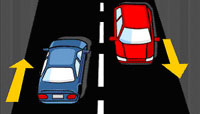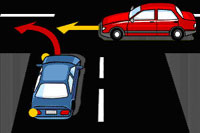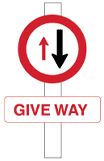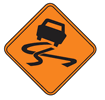Driving in NZ
Driving in New Zealand is not difficult. The following hints should help you have a safe trip.

You can find more road rules at the nzta.govt.nz website Also, pick up a copy of the Road Code from the NZ Automobile Association or bookshops.
You can legally drive in New Zealand for up to 12 months from the date you entered New Zealand if you have either a current and valid driver's licence from your home country or an International Driving Permit.
- You must carry your licence while driving, including your home country driver's licence or permit where you are using an International Driving Permit.
- Do not drink and drive in New Zealand - drinking and driving laws are strictly enforced.
- You must always wear a safety belt, both in the front and back seats - it's the law.
- KEEP LEFT! - Always drive on the left side of the road!

SPEED LIMITS
WATCH YOUR SPEED! - Driving speeds in New Zealand are varied however always well signposted showing the maximum speed you can travel. However, at times you may need to drive at a slower speed due to road or weather conditions. On most of New Zealand's main roads the speed limit is 100 km/h unless a sign says a lower speed applies. In urban areas, the speed limit is usually 50 km/h unless a sign says otherwise.
 |
The maximum speed limit for urban areas is 50km/h. |
 |
The maximum speed on the open road is 100km/h. |
 |
An Open Road sign indicates a 100km/h speed limit. |
MOTORWAYS
What are the rules for driving on a motorway?
Keep to the left hand lane unless you are passing and always indicate at least three seconds before changing lanes.
On a motorway you must not:
- Walk or cycle
- Stop your vehicle
- Make a U-turn.
TRAFFIC SIGNALS
 |
Red light You must stop. You cannot turn left when there is a red light at an intersection. |
 |
Green arrow, red light Here you may turn right, but may not turn left or go straight ahead. |
 |
Yellow light Stop unless you are too close to the lights to do so safely. |
 |
Yellow arrow, yellow light Whether you are turning or going straight ahead you must stop if you can do so safely. |
 |
Green light Go, but give way (yield) if you are turning. |
 |
Red arrow, green light Here you can not turn right, but may go straight ahead or turn to the left if it is safe. |
INTERSECTIONS
 |
STOP MEANS STOP! - A Stop sign means just that... stop, give way (yield) to all traffic before moving. |
 |
GIVE WAY! - At an intersection where one vehicle will cross the path of another, and both are waiting on stop or give way signs (or where there are no signs), normal give way rules apply. This means that if you're turning, give way to all vehicles that are not turning. |
What are the rules at intersections?
- Always use your indicators.
- Always obey the traffic lights, signs and arrows marked on the roads.
If turning,
- Always use your indicators.
- Give way (yield) to all traffic not turning.

OVERTAKING
Most New Zealand roads have a single lane in each direction and you will find plenty of passing lanes at regular intervals so that you can safely pass any slower vehicles (or allow other vehicles to pass you). NEVER cross a solid yellow line on your side of the centre-line, as this indicates it is too dangerous to over take.
ONE LANE BRIDGES
A lot of New Zealand roads have one lane bridges, which means vehicles travelling in one direction must give way to vehicles going in the other direction. These are always well signposted, showing which 'side of the bridge' has to give way (yield).
 |
 |
 |
| Give way to traffic |
Give way to traffic |
Proceed with caution |
 |
WATCH THAT STOCK! - New Zealand has a large amount of rural land, and while this makes driving a more scenic experience, you must be aware of stock on the road such as cows, sheep, deer and horses. When you see a horse or other stock, you must slow down and do NOT sound your horn as you may startle the animal! You may need to stop and let the animal(s) go past you or move slowly past. |
 |
SKATING ON THIN ICE! - During winter some New Zealand roads can become hazardous. Look out for slippery surface signs in wet or icy conditions, which means you need to slow down and avoid braking suddenly! |
NO NEED TO RUSH!
It is easy to look at a map and underestimate travelling times in New Zealand. Therefore make sure you leave yourself plenty of travelling time, get lots of rests before a long drive, take a break every couple of hours and if you begin to feel tired or sleepy, try a 40 minute power nap or find a place to stay overnight.